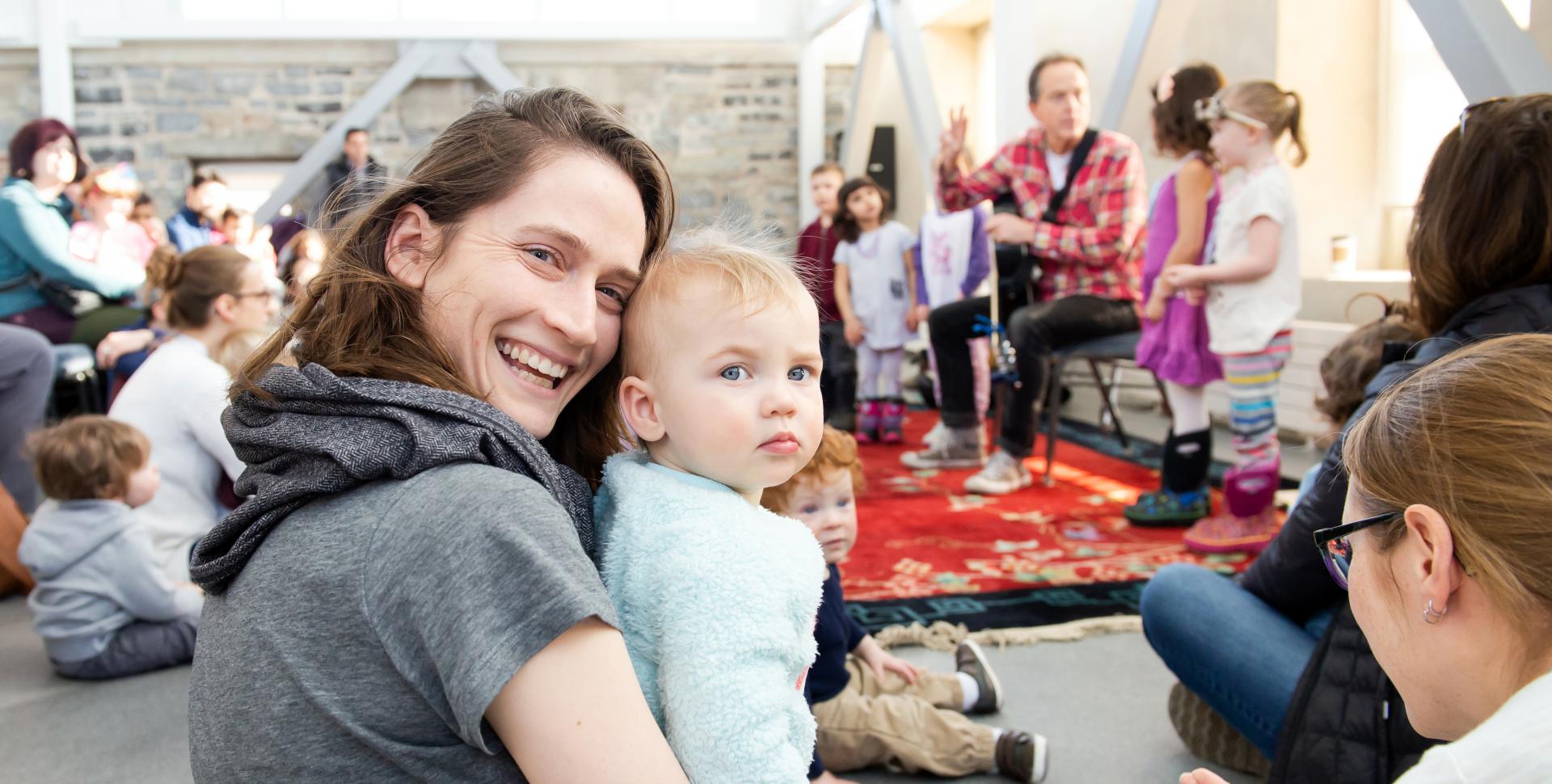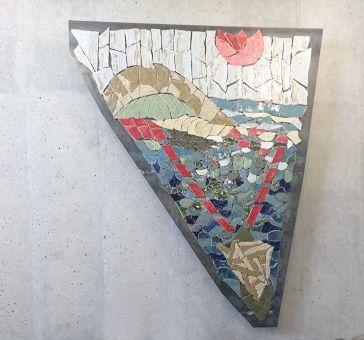
A thriving hub of artistic creation, learning and exchange that engages and inspires every part of our community.
Tett Centre for Creativity & Learning is a charitable arts organization, operating in the beautiful J.K. Tett heritage building on Lake Ontario's waterfront in Kingston, Ontario. This historic building is owned by the City of Kingston and was fully renovated in 2015. It originally formed part of the Morton Brewery and Distillery Company, which was built in the mid-19th century.
The J.K. Tett Centre is home to nine arts organizations, eight artist studios, and a variety of rental spaces, including the Malting Tower, Rehearsal Hall, Tett Gallery and Activity Room. We are also home to the fully licensed Juniper Café, with a waterfront patio and stunning views of Lake Ontario. Find out about our tenant organizations and Juniper Café here.
Together with our resident arts organizations, Tett Centre is part of an arts hub that also includes the Queen’s University world class performing arts facility, the Isabel Bader Centre for the Performing Arts. Tett Centre offers many opportunities to immerse yourself in Canadian arts: classes, workshops, exhibitions, open house events. Find information about upcoming events here.
Tett Centre contributes to a vibrant arts community in Kingston by fostering collaboration among the tenant groups and with Queen's University, the Kingston community and beyond. The fully accessible J.K. Tett building is used by and home to artists of all disciplines and levels of expertise.
____________________________________
We are thrilled to present our 10th anniversary documentary below, titled 𝗧𝗲𝘁𝘁 𝗖𝗲𝗻𝘁𝗿𝗲 𝗦𝘁𝗼𝗿𝘆, created by local filmmakers Hanan Zeineldin and Juan Velasco. The mini doc is a beautiful snapshot of the Tett — capturing the magic, creativity, and essence of our building and the vibrant community within it.
A heartfelt thank you to everyone involved in the film, especially Tett Program Coordinator, Jung-Ah Kim, whose dedication and support were instrumental in bringing this film to life. We hope you enjoy it!
A thriving hub of artistic creation, learning and exchange that engages and inspires every part of our community.
To make space for arts exploration, artistic development and creative incubation in Kingston. We do this through a welcoming community hub that brings together spaces, people, ideas and tools that support creativity and learning experiences.
The Tett Centre for Creativity & Learning is a not-for-profit corporation governed by an independent, community-based board, which is accountable to its membership: the City of Kingston as represented by Mayor and Council.
Within its broader mission, the Tett is mandated (and funded in part) by the City of Kingston to operate the City-owned J.K. Tett Centre as an accessible multi-use arts centre that supports cultural vitality throughout the region.

Tett Centre for Creativity & Learning is pleased to present the new 2023-2028 Strategic Plan.
After launching consultations with community members to help inform the development of our new strategic plan in 2022, we have been able to focus our vision and identify areas for improvement, challenges, and opportunities to better serve our community. The new strategic plan, with its renewed mission and vision, will guide our work and growth over the next five years. We are excited to continue nurturing our community's artistic potential and facilitate engagement with the arts.
Read the Strategic Plan here
Read our most recent Report to the City of Kingston
Each year, Tett Centre for Creativity & Learning presents a report to the City of Kingston as a testament to our on-going commitment to the Department of Cultural Services to operate the building in a professional and financially sustainable manner, to facilitate quality artistic and creative experiences, and to offer a broad range of community-based arts programming.
*To obtain a high-quality version of this report for print, please contact communications@tettcentre.org
Our organization, the Tett Centre for Creativity & Learning, operates the J.K. Tett Centre which is one of many designated heritage sites in Kingston.
Tett has a beautiful waterfront location, is close to Portsmouth Village and the Alwington and Sunnyside neighbourhoods as well as Portsmouth Olympic Harbour, Queen's University and downtown Kingston.
Both the J. K. Tett Centre, and the adjacent Stella Buck Building, originally formed part of the Morton Brewery and Distillery complex that was reputed to be the largest of its kind in North America during the mid-19th century. James Morton himself was involved in lumbering, shipping, the Grand Trunk railroad and a furniture business utilizing convict labour.
The building and the site have also served as a military hospital, a regional headquarters for National Defense, office space for City staff and, more recently, as home to a number of cultural groups and not-for-profit organizations. This creative use of the site was initiated by John K. Tett, a former Director of Recreation for the City of Kingston, for whom the J.K. Tett Centre was named.
by Dorothy Young © 2010
The heritage site we know as the J.K. Tett Centre was originally part of a complex of buildings forming the Kingston Brewery and Distillery owned by James Morton. An article in the British Whig, Friday, March 1, 1844 entitled "Mr. Morton's Mammoth Brewery" gives us a very clear idea of the site and its workings.
"Having lately paid a visit to the most extensive establishment, the largest on the continent of America, we have been induced to favour the public with a slight description of Mr. Morton's property... He at present has completed a new distillery capable of consuming 50 bushels of grain daily... there are 32 immense fermentation tanks of 3,000 gallons each... The brewery is capable of producing 100 barrels of beer weekly." The article continues with descriptions of the buildings and its various products including — baking soda.
It is interesting to note that during this period the population of Kingston was approximately 5,000 and there were 136 licensed taverns! Morton's establishment was only one of approximately 10 breweries and distilleries but his was the largest.
Morton was well trained in the brewing and distillery business. He arrived in Kingston in 1824 from Ireland and began working at a small brewery and distillery near the corner of Ontario and West Streets. Thomas Molson, son of John Molson founder of the Molson brewing dynasty was his employer. In 1831 Molson purchased a small brewery on King St. West and Morton ran the business as a tenant brewer. Molson sold the property shortly after and over the next nine years Morton continued on as a tenant or partner of various owners until 1840 when he was able to purchase the property himself and set up his "Mammoth Brewery and Distillery". He continued to expand the facility, building tenements for workers, a malt house, and stables. By 1850 the City Directory states that between 60 and 70 families were supported by the business. Morton also purchased the wonderful yellow mansion to the west, St. Helen's, changing its name to "Mortonwood".
The 1850s were a boom period and Morton was involved in many different enterprises including lumbering, shipping, the Grand Trunk railroad and a furniture business utilizing convict labour. He was elected to the provincial legislature and was one of two trustees of the Time and Beacon Assurance Co., head office, Kingston. The other trustee was the Hon. John A. Macdonald, her Majesty's Attorney General.
But as with all booms, there was a bust and by the end of the decade a recession set in and Morton was bankrupt and owed over $250,000. He died at Mortonwood in July 1864.
The business continued for a few more years and it was during this period that a watchman, Cornelius Driscol, was murdered at the site. The perpetrator was captured, tried and subsequently executed. However, there is a legend that the ghost of Driscol still walks the site, checking the doors and locks as he goes.
Over the next few decades the property was sold a number of times eventually being used for storage. With the First World War and the need for military hospitals, the Government of Canada expropriated Mortonwood in January, 1918 converting it to the Ongwanada Military Hospital and in July of the same year the brewery was expropriated and the Sydenham Military Hospital established.
In 1924 the buildings were converted to house the Eastern Ontario Army Headquarters. Little changed until 1966 when the forces were unified and EOAHQ was moved to Ottawa. Two years later the upper property was transferred to Corrections Services and in 1971 the lower property was purchased by the City of Kingston for $120,000.00.
This purchase was the vision of the Director of Recreation at the time — John K. Tett. He saw the possibilities for use of the site by the cultural and arts groups in the city but most unfortunately he was killed in an accident before he could realize that vision. By 1973, a variety of cultural groups had taken up residency after renovating the various spaces to suit the purposes required. The building was named after John Tett in recognition of his vision. At the same time, the large western building was converted for use as a training facility for socially disadvantaged and handicapped individuals and it was named after a local social worker, Stella Buck. The stables became Domino Theatre.
The buildings of Morton's Brewery and Distillery are a fine example of nineteenth century industrial architecture. In our postindustrial age we celebrate the legacy of our leaders and politicians but not that of the average citizen who actually did the work. Our industries were where people found employment to sustain their families, allowing our community to grow. The buildings that make up the J.K. Tett Centre complex are a testament to their work and contribution and are a very real part of the heritage of this community; a fact that should be well celebrated.

In 2017, Tett Centre partnered with Waterlution for Great Art for Great Lakes (GAGL). This initiative involved community participation projects in eight different cities, each focusing on ideas that highlight the grandeur of the Great Lakes and its connection to its people, their history, and diverse cultures. Through a series of public workshops or actions, each community worked towards the co-creation of a permanent artwork as part of celebrating Canada’s 150th birthday.
We are very proud to be home for Aqua Viva, the GAGL community art project coordinated by Kingston’s chosen lead artist, sculptor Andy Berg with local participants.
Aqua Viva began as a community engagement process to discover, celebrate and foster Kingston’s special relationship to the waters of our own Great Lake, Lake Ontario. Through Berg's artistic process, she led participants along the lakeshore, appreciating the lake environment with many senses. Thus inspired, she then guided visualization and facilitated text and clay-medium maker-workshops. As a completed project, Aqua Viva is a low-relief, glazed and fired polychromatic stoneware wall work which articulates shared community values, hopes and relationships to the gift of our special Great Lake environment. This beautiful piece, located in the J.K. Tett Centre’s main stairwell, incorporates community text and symbols, lake environment elements, and an ecological narrative that revitalizes a Canadian icon and local Lake Ontario inhabitant, namely: Amik, Tsyennì:to, le Castor, Beaver.
For more information, please visit the Great Art for Great Lakes link here!